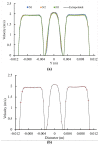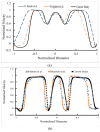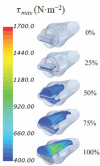Adverse Hemodynamic Conditions Associated with Mechanical Heart Valve Leaflet Immobility
- PMID: 30223603
- PMCID: PMC6165326
- DOI: 10.3390/bioengineering5030074
Adverse Hemodynamic Conditions Associated with Mechanical Heart Valve Leaflet Immobility
Abstract
Artificial heart valves may dysfunction, leading to thrombus and/or pannus formations. Computational fluid dynamics is a promising tool for improved understanding of heart valve hemodynamics that quantify detailed flow velocities and turbulent stresses to complement Doppler measurements. This combined information can assist in choosing optimal prosthesis for individual patients, aiding in the development of improved valve designs, and illuminating subtle changes to help guide more timely early intervention of valve dysfunction. In this computational study, flow characteristics around a bileaflet mechanical heart valve were investigated. The study focused on the hemodynamic effects of leaflet immobility, specifically, where one leaflet does not fully open. Results showed that leaflet immobility increased the principal turbulent stresses (up to 400%), and increased forces and moments on both leaflets (up to 600% and 4000%, respectively). These unfavorable conditions elevate the risk of blood cell damage and platelet activation, which are known to cascade to more severe leaflet dysfunction. Leaflet immobility appeared to cause maximal velocity within the lateral orifices. This points to the possible importance of measuring maximal velocity at the lateral orifices by Doppler ultrasound (in addition to the central orifice, which is current practice) to determine accurate pressure gradients as markers of valve dysfunction.
Keywords: adverse hemodynamics; bileaflet mechanical heart valve; blood damage; computational fluid dynamics; platelet activation; transvalvular pressure gradients; turbulent shear stresses.
Conflict of interest statement
No conflict of interest to be declared.
Figures











Similar articles
-
Numerical and experimental investigations of pulsatile blood flow pattern through a dysfunctional mechanical heart valve.J Biomech. 2010 May 28;43(8):1565-72. doi: 10.1016/j.jbiomech.2010.01.029. Epub 2010 Feb 25. J Biomech. 2010. PMID: 20188372
-
Impact of design parameters on bileaflet mechanical heart valve flow dynamics.J Heart Valve Dis. 2009 Sep;18(5):535-45. J Heart Valve Dis. 2009. PMID: 20099695 Free PMC article.
-
Are the Current Doppler Echocardiography Criteria Able to Discriminate Mitral Bileaflet Mechanical Heart Valve Malfunction? An In Vitro Study.Artif Organs. 2016 May;40(5):E52-60. doi: 10.1111/aor.12653. Epub 2016 Jan 27. Artif Organs. 2016. PMID: 26813110
-
Particle image velocimetry investigation of intravalvular flow fields of a bileaflet mechanical heart valve in a pulsatile flow.J Heart Valve Dis. 2000 Sep;9(5):721-31. J Heart Valve Dis. 2000. PMID: 11041190
-
Flow in prosthetic heart valves: state-of-the-art and future directions.Ann Biomed Eng. 2005 Dec;33(12):1689-94. doi: 10.1007/s10439-005-8759-z. Ann Biomed Eng. 2005. PMID: 16389514 Review.
Cited by
-
Introduction to the Special Issue on Advances in Biological Tissue Biomechanics.Bioengineering (Basel). 2020 Aug 17;7(3):95. doi: 10.3390/bioengineering7030095. Bioengineering (Basel). 2020. PMID: 32824476 Free PMC article. No abstract available.
-
Advanced Methodology and Preliminary Measurements of Molecular and Mechanical Properties of Heart Valves under Dynamic Strain.Int J Mol Sci. 2020 Jan 24;21(3):763. doi: 10.3390/ijms21030763. Int J Mol Sci. 2020. PMID: 31991583 Free PMC article.
-
Finite Element Driven Design Domain Identification of a Beating Left Ventricular Simulator.Bioengineering (Basel). 2019 Sep 13;6(3):83. doi: 10.3390/bioengineering6030083. Bioengineering (Basel). 2019. PMID: 31540196 Free PMC article.
-
Rethinking mechanical heart valves in the aortic position: new paradigms in design and testing.Front Cardiovasc Med. 2025 Jan 30;11:1458809. doi: 10.3389/fcvm.2024.1458809. eCollection 2024. Front Cardiovasc Med. 2025. PMID: 39949724 Free PMC article. Review.
-
Extraction of Peak Velocity Profiles from Doppler Echocardiography Using Image Processing.Bioengineering (Basel). 2019 Jul 26;6(3):64. doi: 10.3390/bioengineering6030064. Bioengineering (Basel). 2019. PMID: 31357566 Free PMC article.
References
-
- WHO Fact sheet: Cardiovascular Diseases (CVDs) [(accessed on 16 September 2018)]; Available online: http://www.who.int/mediacentre/factsheets/fs317/en/
-
- Khalili F., Gamage P.P.T., Mansy H.A. Prediction of Turbulent Shear Stresses through Dysfunctional Bileaflet Mechanical Heart Valves using Computational Fluid Dynamics; Proceedings of the 3rd Thermal and Fluids Engineering Conference (TFEC); Fort Lauderdale, FL, USA. 4–7 March 2018; pp. 1–9.
Grants and funding
LinkOut - more resources
Full Text Sources
Other Literature Sources

